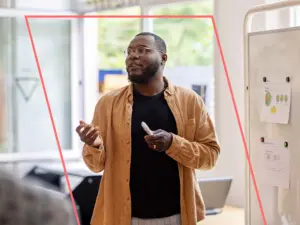We talk to President and CEO Meredith Bronk and Stratum Co-founder and CEO Ryan Trimberger about a breaking news development. We acquired Texas-based cloud service provider Stratum Technology on December 31, 2021. For both organizations, the acquisition means that clients will have access to more support, experience and expertise than ever before. Learn more in this podcast episode about what’s next.
Enjoy!
This podcast content was created prior to our rebrand and may contain references to our previous name (OST) and brand elements. Although our brand has changed, the information shared continues to be relevant and valuable.
Episode Transcript
Kiran: Hello, welcome to Ten Thousand Feet: the OST podcast. Today, we are going to be talking about an exciting development from OST that involves our cloud capabilities. If you would like to learn more about OSTs cloud offerings, visit OSTusa.com/cloud. Enjoy the episode.
I’m Kiran Patel, and I’m so excited to have OST president and CEO Meredith Bronk with us today as well as Stratum co-founder and CEO, Ryan Trimberger. Fresh on the heels of the announcement of OST’s acquisition of Stratum Technology, Meredith, welcome to the show.
Meredith: Thanks Kiran. Glad to be here.
Kiran: And Ryan so great to have you today.
View Full Transcript
Ryan: Thank you so much for inviting me.
Kiran: Stratum Technology is based in Texas and is a cloud services provider.
This acquisition expands OST’s cloud services capabilities thanks to Stratum’s deep technical expertise and certifications in both AWS and Microsoft. Stratum joins OST with architects, engineers, and project managers who have developed relationships with top partners and carry advanced specializations such as the Microsoft Azure expert managed services provider designation. It’s a great opportunity to have both of you today just to talk through how all of this came to be. So naturally I want to start at the beginning. Mer, can you tell us a little bit about how this was dreamed up and what led to this announcement?
Meredith: Sure. This is a fun part, kind of going back and telling the story a little. And it’s interesting from my perspective, when I think about, and look at what’s happening just in our industry and really kind of across the board with acquisitions, with organizations coming together and the why behind so much movement. And for us, I won’t speak to other folks’ motivation, but for us in coming together, we’ve done a few other targeted acquisitions.
And when we look at growth strategy and we look at our purpose in providing an opportunity for folks to do what they’re really, really great at in solving the complex and future-oriented kind of technology problems that our large enterprise clients are solving our ability to be able to stay right ahead of that is what drives us every day.
And we’ve made a couple of other targeted acquisitions in the past. And so continuing to look for opportunities to fill a much needed kind of talent place from a competency perspective, access to market and just aligned mindset and technologists also, if you will, like looking for that right combination for us to supplement the organic growth that we’ve had is always something that we’ve had our eye on, but certainly over the course of the last year or two in the cloud space created an opportunity.
So when we started to kind of open our eyes to the possibility and had the opportunity to meet Ryan and Aaron, the other co-founder at Stratum, there was just a natural kind of excitement and energy that comes when you first come together with other folks who A. are like-minded, but B. who were solving similar problems with a similar approach.
And the opportunity and the likelihood for us to come together to really truly make a difference for both our employees and our clients was evident kind of right from the start. So it was exciting to create that opportunity.
Kiran: And Ryan tell us about that meeting. I mean, the energy, the possibility I’m sure both of your heads were just spinning with what was possible with this union.
Ryan: Yeah. I mean kind of hard to tell what Meredith just said, but I’lll just echo that in that when we started chatting with Mer and Jim and some other key folks on the leadership team. It was a natural fit almost. We were almost clicking right out of the gate. And from the Stratum side, you know, we saw the activity in the marketplace. We saw these big organizations getting even bigger, but for us, that wasn’t the goal was just to get bigger for bigger sake. It was really tactical for key offerings that allowed us to serve our customers better and deeper on the technology stacks that were near and dear for their business strategies.
And that really drove a lot of the conversations with OST and what made it such a great fit. We have a pretty large investment into our healthcare practice for specifically the Epic on the cloud. What we found was customers were asking us to go deeper on those Epic workloads and we’re cloud folks. We’re not deep in the weeds. We’re not in the code in Epic, but there was a big appetite for that. So we knew if we were going to make our customers happy over the next 10 years, we needed to have those skills. And so as we started to evaluate, where would people fit in? Where, where do we draw the line? Where would OST take over on some of these? We almost started to blur the line pretty quickly on what you do this, you do this. So this is a perfect marriage and it really just went from there.
Meredith: I love that part of the story too I think Ryan, even you telling it kind of takes me back. It’s like not only are the industries aligned, obviously with the Epic in the cloud kind of shared focus that both Stratum and OST have had for a long time, but the size was right that together we’re still so nimble, but yet also deep.
And that for our clients who want to know that they matter for the folks who know that they want to be able to pick up the phone and talk to somebody who knows and is invested in them, just like they’ve had with the Stratum team, like they’ve had with the OST team that bringing these two groups together, you don’t lose that.
Like that only gets enhanced. And as we were talking about the possibilities like that shared reality and that the excitement for us and for the folks in talking to our teams, right. And talking to the teams about coming together, that’s what they were excited about, the opportunity and the solutions and they know in having sat next to our clients and heard about firsthand, Hey, could you help me with– that they understood firsthand the possibilities that this could solve. And that excitement only grew.
Kiran: That’s a perfect transition to talking more about what’s possible now. So we have a new strong partnership. We have a lot that can happen. So Mer talk a little bit about some of the new possibilities that you see and some of these joint capabilities that our clients and those we serve can come to expect now.
Meredith: When I think about it, you know, my mind goes to depth in places that from OST’s perspective, we have a broad capability set for an organization our size. We help large enterprises, right? And healthcare companies solve both how and where technology runs and how am I going to use technology to change my business. And for some companies, a hundred-year-old manufacturing companies, even some healthcare organizations, those decisions have been made discreetly like in different silos and different parts of the organization for a long, long time.
They’re running together. They’re on this collision course and cloud in particular lives in so many places. Inside our client’s kind of organizations. And so when I think about the possibilities today, so we have software development and we develop, you know, cloud native, and we have managed services capabilities where we’re helping to run enterprises that are both in the cloud and on-prem right in a hybrid environment. So we’ve had these kind of cloud capabilities dispersed throughout OST’s kind of full breadth and partnering with Stratum brings depth in places, particularly when I think about the platforming, when I think about the ability to manage and migrate. And I think about the operational aspects of what it brings when I think about the deep partnerships with Microsoft, with AWS. When I– really when I think about what that really, really means in that space to both bring to our customers and bring to the partners that to me is probably the thing that I’m most excited about and what it brings in the new that we have the breadth, and we still kind of had that sprinkled about. And now we’ve also brought some depth.
Kiran: Ryan, what about you? What do you see as something that’s possible?
Ryan: Well, we’re quick out of the gate already. We’ve already got a number of wins under our belt, and we’re talking about integration in just over a month. So it’s been fast already, but when I think about the near term in the long-term, I think about easy-to-deploy solutions for a number of different clients, regardless of their industry. Mer mentioned the a hundred year old manufacturing company. We’ve got services that are easily consumable that are going to be coming to the marketplace so they can digest those through that if they don’t want to have maybe more of a deeper engagement, if they need something, that’s a quick win, we’ve got a networking solution that they can deploy their network to the cloud in a number of days.
And so that’s one way for IT and the business to move quickly and leapfrog competitors. But I also think about other organizations like private equity firms or organizations that might be backed by private equity that are doing acquisitions. We’ve got a scalable, repeatable playbook that allows those organizations to move quickly, not have to require on a lot of headcount, which is very, very difficult in the market that we’re in for hiring and retaining talent.
It allows them to leapfrog competitors to really create a lot of business and technical efficiencies they just can’t do with other partners. So when I think about what we can do together, it’s really taking that nimble aspect of really a smaller boutique firm, but a firm that is fast and can outbeat some of the global SIs for time to market to meet both customer needs and partner needs.
Meredith: I love that. I love that. I think about velocity that you had on and the talent piece. I think that’s a really interesting dynamic that’s happening obviously for our clients and our ability to kind of step into that space, especially as it relates to where you put your resources. And our ability and one of the things that the stratum team has done is their expertise in automation that brings some of that velocity with playbooks, with like, what do you need? Yep. We’ve done that. Like, let’s, let’s do that quickly for you to get you moved. And the capability that that brings and the velocity that that brings is remarkable. In addition to that, I think in our ability to manage environments and the kind of managed capability that we have, and that stratum has had so that our clients can leverage their workforce toward the business also in other areas, because talent is tough. So I love that Ryan hit on that because that’s definitely something that we hear a lot.
Kiran: Ryan, I’m sure that you have been watching this space and just observing, especially a lot of the changes that we’ve seen recently. Is there something in particular that you’re predicting will occur next or any trends that you’ve recently discovered that you might be able to share or comment on at all?
Ryan: Sure. Well, I think the cloud space will continue to consolidate. I think you’ll see global SIS continue to get bigger, but I think what’s going to be interesting is a lot of the peers for stratum that were our size were gobbled up by very large global SIS. And so there’s really not a whole lot of competition or like-minded, or, or like size companies that are providing similar services for end-to-end cloud and other technology solutions like OST is that are really left in the marketplace that can be nimble enough to meet needs at a fast pace, but also be able to pick up the phone and call me out of the blue. I’ll be able to take those calls. You can’t get that kind of white glove service with other providers. Which I think is rare in our space, particularly where things are going for the hunt for talent.
The other thing that I would say is more companies like the a hundred year old manufacturing company. They’re realizing that they’re no longer a manufacturing company. They’re a technology company. And they’re realizing that, and they’re using technology, not as a cost center, it’s really as an enabler to grow their business and connect with their clients.
That could be a number of things from customer experience. That could be aspects of being able to configure things online. Similar if you might be shopping for a car, there’s no reason you can’t do that for any other product in the market today. But even down to how you connect with your customers on an ongoing basis for things like maintenance, we’re talking to a manufacturer right now that they’re looking at using the data from their customers that allow them to be proactive on maintenance for their customers so they can keep those customers happy. So they can also figure out where they need to go to find new ways to cater to new service offerings. So I think you’ll find more and more companies are thinking like we might’ve thought as Google, Facebook, Microsoft, Amazon 10 years ago, you know, the big tech you’re finding more and more old school customers thinking like a software company,
Kiran: Mer, has there been a trend or observation you’ve come upon recently that you’d like to share?
Meredith: Yeah, I think, you know, Ryan had on a lot of them, both in our industry, as it relates to kind of what’s happening with, you know, solution providers and consulting organizations.
The interesting thing, maybe at the core of part of what Ryan hit on also in industry is for so long, the CIO’s meeting the needs of the business and the business kind of thinking about how it interacts with IT. My take is over the course of the last four or five years, that especially as accelerated by the pandemic that organizations have figured that out, or they’re likely no longer relevant right now, they’re already on a kind of a downhill. You know, a slide of it. So what we’re seeing right now, what I’m seeing right now is that the CIO’s who’ve made the turn, the businesses who figured out how to leverage IT. The folks who are doing that and doing that well together. And there are a lot of organizations who are doing that well together, the possibilities that are now being uncovered and the needs that we have to be able to solve. We have to be able to also solve hand and glove. So for us to be able to put an architect and a designer and a cloud architect, right. And a software developer all together on a team that agility that Ryan talked about is that the velocity that’s required now that the business and the technologists, if you will, have figured out together how to run. It also means that they need partners like us, who can bring that same level of agility. And so if I think about kind of the turn that our business has made the last five years, six years in bringing that to bear the trend that I see is further acceleration and the further blurring of lines, whether it’s digital technology and I’ve been technology like in air quotes, almost like what is technology anymore? Manufacturing is tech. Marketing is tech. Digital is tech. Tech is digital.
I talked to college kids today, right. And we’re talking to folks who are coming up in the industry. It’s like how we think about our industry fundamentally shift. And I have a daughter who’s about to graduate from college and she’s like, it seems like all of the industries are in tech. You know, all the jobs are in technology and I’m like, every job requires technology and technology influences everything that we do.
And that is just a reality and we’re well positioned for that reality. But I think the continued push in that direction, I think it will just continue to accelerate and COVID obviously accelerated it, but the businesses that didn’t make the turn didn’t make the turn.
Kiran: Yeah. So have either one of you seen examples of entities that are starting to consider the cloud and, are doing this successfully, maybe entities that we’ve worked with or examples of those that we’re helping through the transition and maybe just how that’s going for them.
Meredith: Yeah, there’s a lot I’ll say. And I’ll let Ryan, Ryan’s obviously way more of an expert than I am on this. I’ll say there’s an interesting data point. I think I saw out there, it was, I think it was in 2020 was the first time globally that spend in the cloud exceeded spend in traditional infrastructure.
And so it’s like it finally made the eclipse and while that’s true, I think there’s a data point and I’ll get it wrong, but you know, directionally I think there’s still like 60 or 70% of the workloads are still run on prem.
So it’s a really interesting like dynamic because traditional applications that are running, organizations are still run the old way. Like they’re still like, oh yeah. That thing in the closet. Yeah. That’s still running. That’s still running back where it was. The new is running in the cloud. And so getting folks who can get rid of the technical debt that they have is a big, big, big push.
And there are organizations. I know we have some stories of places where we’re doing that well, in addition to building the new. Because the building of the new, most of that is this happening in the cloud, but also getting the, getting the old and transforming that that’s the hard work that our teams are doing right now.
I don’t know Ryan, if you want to share a story or two.
Ryan: Yeah. We’re finding organizations that historically were some of the last movers for cloud adoption. Think financial institutions, asset managers, even people that are better in the payment side of the business are shifting more than 60%, almost 75% of their workloads to the cloud because they’re looking for agility.
These are organizations that have been around for 250 years that have a us presence, a European presence. And they have a very complex customer base, a very complex organization structure, but they’ve realized in a world that’s not just COVID when people are working from home the needs to have a digital footprint.
But to stay competitive with FinTech, to be able to reach new markets for investments, these organizations are pivoting how they think about the day-to-day of their business. So we see that front, everything from financial institutions, even down to organizations that are government contractors or serve state and local government like towing authorities, they’re moving their are applications to the cloud to reach new demand, to be more efficient, to cut costs. We’ve got a very large organization called trains Corp, which is a customer of ours that they’re moving more and more of their workloads to the cloud because they can be competitive on their bids. So it allows them to cut costs and also from a deployment standpoint, be up in a matter of months, not , in some cases, years for this infrastructure to be stood up fine tuned. This is something that we can do through automation through runbooks and really allows them to improve the customer service for their end customers, which is the people.
So this is a great story for really, for everybody.
Meredith: The other thing I think when I think about that too, Ryan, I know, I know you’re hearing some stories is around supply chain concerns. And when you’re hearing about supply chain constraints, the ability to move quickly is happening also to the cloud, right?
Like you have to be able to serve your constituents and with yeah. Totaling, it is your it’s us, right. The public and the ability to move quickly. And certainly the supply, some of the supply chain issues have also had an impact on that.
Kiran: So stratum is here. We are rolling. We are moving. What’s next. What’s coming in the next six months or so. And what can our clients and those we serve, expect to see on the horizon soon.
Meredith: Yeah, we’re rolling. We are rolling. We’re about a one month in right now. I would say what’s next is the integration is underway. We’re right now spending some time getting to know each other’s client base, getting to know to make sure that we’re leveraging the skills and capability that we’re also though making sure that everybody is well taken care of that our teams are well taken care of that the clients are well taken care of that there’s not a disruption.
And then that we’re building upon. So I would also expect to see this as a place where, when I think about acquisition, it’s like an acquisition and then upon which comes organic growth. So this is like the beginning , or the continuation of a growth strategy for us, where we find just continued opportunity to leverage deep, deep competence and capability.
I think in particular, we’ll see continued advancement in the epic in the cloud space. That is an area that together we have a absolutely fantastic reach and amazing resources and something that we know that we want to leverage both with our partners who were telling us thank you. Thank you. Let’s go get them.
So I think we’ll see some more push, particularly in that space. That’s something that we’re excited about. And then just in general, you mentioned kind of at the opening with the deep expertise that stratum brings to the table with Azure expert MSP designation. That there’s a lot of movement in general. And we talked about velocity in ensuring that folks are well taken care of as they move their workloads to the cloud. And so I think that’s another place that for us, you could see some movement into an acceleration into and confidence into, as we can look to grow what we’re doing with that and how we expand to take advantage of kind of into that space and leverage that expertise.
Ryan: I would echo that. I’d also just like to give a thank you to all of the loyal customers and partners. We certainly can’t do this without you. And I think you’ll find pretty quickly on both sides for customers and partners there’s going to be ways that we can now better serve you. I was just on a call this morning prior to this recording, where we were talking to an existing stratum customer that six, seven months ago, they had asked us about a potential project that was on their priority list.
And at the time we had to say sorry, we, we don’t have this skill set. We’d have to go find a contractor. We’d potentially have to recruit for this. I’d rather not put you in that position. And this is not something that we are the best in the industry at. And they brought it back up today with the acquisition news and lo and behold, we’ve got a bench of people that already do this. They’re the best in the business at this. And we’re putting together a statement of work to help this customer move their business forward. So that’s on the customer side, but also on the partner side. It’s opportunity for us to be really a ramp to other areas and different workloads to help accelerate cloud growth and really allow our partners to be better suited for our customers too, because now we can reach more deep barriers of Kubernetes. We can do dev ops, we can do application development. We can do really the entire life cycle or journey of the cloud. So I think everybody wins in this scenario, including our partners.
Meredith: I love that. And I, and I echo the gratitude and the sentiment there. We’ve truly, truly grateful for the partnerships that we’ve had.
Our vendor partners, our clients, and the trust that our teams, Ryan and Erin working through this process, even in coming together, just truly grateful for the trust and the faith and the overwhelming excitement and feedback that we’ve gotten so far in sharing the news. People are excited when they hear about what’s happening, which is just fun.
So super grateful for that.
Kiran: That is a perfect thought to close. Mer, is there anything else you wanted to add or any additional final thoughts?
Meredith: Nope. I’m good. I’m just, it’s been fun to have this conversation. I know we’re about one month in more to come and it’s just been, a really, really, really great ride so far.
And I look forward to what 2022 has in store for us joining forces.
Kiran: Ryan, any last words you want to say?
Ryan: I think something that some people might not know from the press releases that we were actually partnering with OST already while we were in due diligence and kind of figuring out if we could dance together before we got to the altar, we were already partnering on a couple of opportunities. So I think you’ll just see a natural, seamless transition for our customers, the way we serve our customers, how we honor our customers. And you’ll see that continue into 2022 and beyond.
Kiran: Fantastic. Thank you both for spending some time today on the podcast. We appreciate your time.
Meredith: Thanks Kiran. Thanks Ryan.
Ryan: Thanks Mer.
Kiran: OST. Changing how the world connects together to dive deeper into all things cloud visit ostusa.com/cloud.




